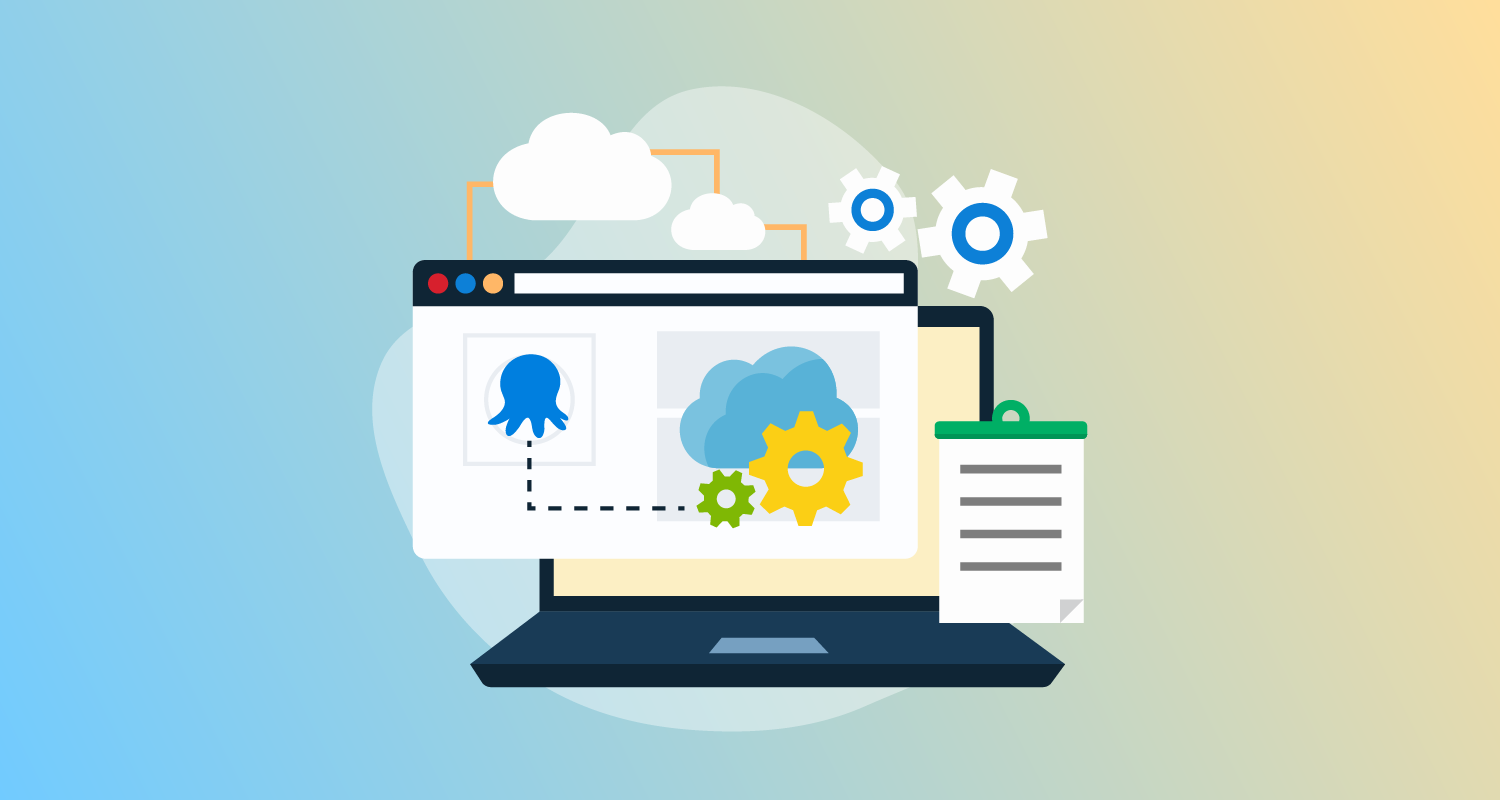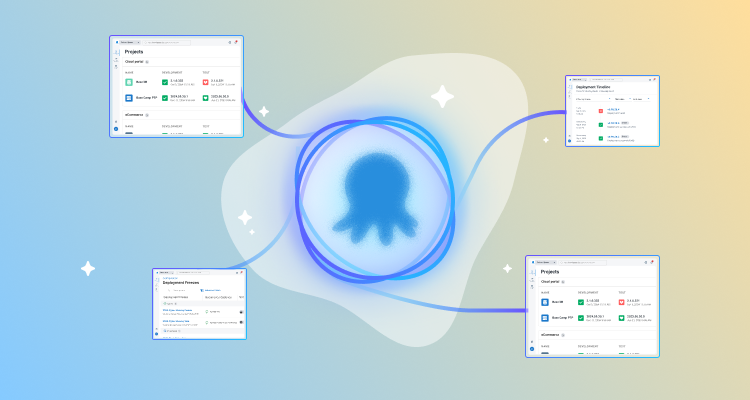What if I told you that you could create a complete, functional Octopus project, based on hand-crafted examples of best practices, by simply typing a prompt like Create a Kubernetes project called "Web App"?
This is exactly what we’re providing with the Octopus AI Assistant.
In this post, I describe how we’re using GenAI to generate Octopus projects, and how you can use this functionality to accelerate your DevOps processes.
Building the templates
GenAI is only as good as the data it has learned from. For GenAI to build a project, along with all the supporting resources, we start by hand crafting a number of template projects according to a set of best practices that we’ve evolved over the years.
At this stage, the template projects are nothing more than regular projects manually created via the web UI. This makes it easy to build and test the project as if it were any other project in Octopus.
Best practices capture aspects like:
- Variable and target tag naming conventions
- Release versioning schemes
- Worker images
- Supporting runbooks
- And much more
There are hundreds of configurable fields in an Octopus project, and we have a continually evolving set of opinions to provide DevOps teams with a solid foundation for their deployment workflows.
Importantly, we do not train an LLM on any customer data.
After we have a template project that embodies our best practices, the next step is to serialize the project to a format that can be passed to an LLM.
Serializing the template
LLMs excel at generating text, and so to have the LLM generate an Octopus project, we need to define projects in a text-based format. We use Terraform, and specifically Terraform implementing the Octopus Terraform provider, to represent the project.
Terraform is a natural choice because:
- We can reasonably expect any large LLM to have been trained on a large body of Terraform examples
- HCL files contain multiple resources and express their relationships via interpolations
- It’s trivial to determine if the result is semantically valid Terraform configuration
Octoterra is used to convert an existing Octopus project into Terraform configuration. This process is automated, providing a short feedback loop where projects can be updated, serialized, and supplied as an example as part of a LLM prompt.
That said, we could not generate a typical Terraform representation of a project. Terraform relies on persistent external state to track the resources it manages, and we wanted to avoid persisting any information about an Octopus instance where possible. Treating the Octopus instance as the single source of truth meant:
- All data stayed securely behind the Octopus API
- It removed issues around keeping external data in sync
- It removed the security concerns around storing and accessing potentially sensitive data
To support these requirements, we generate what we call “stateless” Terraform modules. These modules always pair a data source and the resource to be created in such a way as to create the resource if it didn’t exist or reference the existing resource if it was already present. This is an example:
data "octopusdeploy_environments" "environment_development" {
ids = null
partial_name = "Development"
skip = 0
take = 1
}
resource "octopusdeploy_environment" "environment_development" {
count = "${length(data.octopusdeploy_environments.environment_development.environments) != 0 ? 0 : 1}"
name = "Development"
description = ""
allow_dynamic_infrastructure = true
use_guided_failure = false
}This data source and resource pair result in the count attribute being set to 1 if the Development environment doesn’t exist, thus creating the environment, or sets the count to 0 if the environment is present.
Other resources then use a ternary expression to either reference the existing resource or the newly created one:
resource "octopusdeploy_lifecycle" "lifecycle_application" {
count = "${length(data.octopusdeploy_lifecycles.lifecycle_devsecops.lifecycles) != 0 ? 0 : 1}"
name = "Application"
phase {
automatic_deployment_targets = [
"${length(data.octopusdeploy_environments.environment_development.environments) != 0 ? data.octopusdeploy_environments.environment_development.environments[0].id : octopusdeploy_environment.environment_development[0].id}"
]
optional_deployment_targets = []
name = "Development"
is_optional_phase = false
minimum_environments_before_promotion = 0
}
}This Terraform configuration would not work as expected if it were applied multiple times with a persistent state. Resources would be alternatively created and destroyed as the count associated with a resource toggled between 0 and 1.
However, when the Terraform configuration is run against an empty state, this style of configuration works perfectly. Missing resources are created, and existing resources are left unmodified. This is exactly the behavior we want when generating Octopus resources via the LLM. It provides an imperative method for creating resources if they do not exist, without needing to know anything about the Octopus space where the configuration will be applied.
Training the LLM
After the ability to serialize projects to stateless Terraform modules is in place, we can pass these modules as part of the context of an LLM prompt. This is called one-shot or few-shot prompting, where the LLM is given an example of the task it’s being asked to perform.
These examples got us almost all the way to having an LLM generate a project, and all the supporting resources, from a plain text prompt. However, because the LLMs had not been explicitly trained or fine-tuned on the stateless Terraform modules, we needed some additional prompt instructions to avoid edge cases and steer the LLM towards generating the correct Terraform configuration.
Generating the instructions involved:
- Having an LLM generate multiple sample prompts that we might expect end users to write themselves
- Running the generated prompts and observing the resulting Terraform configuration
- Finding cases where the LLM generated invalid output and refining the prompt instructions to avoid these cases
This is the prompt we used to generate sample prompts:
Given these prompts:
'Create a Kubernetes project called "My K8s Project 2". Add a step to deploy a K8s deployment. Add a step to deploy a Kubernetes ClusterIP service. Use the "Security" lifecycle. Add a step to deploy a Kubernetes ingress resource. Enable variable debugging.'
'Create an Azure Web App project call "My Azure Project 1"`
Write 5 more prompts including a mix of:
feeds
accounts
steps
platforms like helm, kustomize, aws lambdas, azure web apps, azure functions, cloud formation, arm templates, bicep templates
lifecycles
project groups
project names
step run conditions
rollout strategies like blue/green and canary
variables
environments
target tags
packages
cloud providers
retention policies
inline scripts
script from packages
tenanted, untenanted, or tenanted and untenanted deployments
tenants
variable scopes
tenant tags
Do not reuse project names from previous responses.
Include a random number suffix on the project name from 1 to 10000.
Print each example in an individual markdown code block.The generated prompts often requested deployment processes that even an Octopus expert couldn’t implement. The goal was not to generate logically valid output, but to ensure our combination of sample Terraform and custom instructions generated semantically valid output. This demonstrated that the LLM had the examples and instructions needed to generate semantically valid output, meaning it was up to us to provide the correct sample projects to generate logically valid output.
You can view the instructions from the GitHub repository.
Generating the project
Once the LLM was trained, the next step was to execute the generated Terraform configuration to populate the Octopus space.
This was a relatively easy task since we didn’t have to persist any state. So we created an Azure function that:
- Embedded the OpenTofu executable
- Exposed an HTTP endpoint to generate a plan
- Applied the plan after it was approved by the end user
While this is a simple process at a high level, there are a number of security concerns we needed to address:
- The Terraform configuration should only create Octopus resources, not other resources for platforms like Azure or AWS.
- We needed to fail if any sensitive data was included in the generated Terraform configuration because the prompt interface is not secure.
- We needed to enforce the use of local Terraform state and not allow Terraform to try and save state in any external location.
- Any existing resource must not be modified when creating AI generated resources.
The first 2 concerns were addressed by testing the JSON representation of the Terraform plan file with Open Policy Agent. Thanks to the declarative nature of Terraform, it’s possible to determine the provider that will be used to create a resource. We can also identify which attributes the provider marks as sensitive and fail unless the sensitive values are set to dummy values like CHANGE ME.
To enforce the use of local state we implemented Terraform override files. These files are created alongside the generated Terraform configuration and take precedence.
Finally, we could take advantage of the fact that Terraform will not modify resources it does not own, and it will never own anything, because Terraform was always executed with a blank state.
The combination of OPA policies run against plan JSON files and override files let us restrict the creation of AI-generated resources in a way that would have been all but impossible with custom scripts or raw API calls.
Customizing the generated project
All of this is overkill if the purpose is to recreate a template project verbatim. Stateless Terraform modules could be applied unmodified with no need to involve an LLM.
The real power of LLMs are their ability to generate custom responses to any prompt.
The combination of custom LLM instructions, general purpose example Terraform configurations, and specific template project examples lets us prompt the LLM to generate customized projects. For example, we can write a prompt like this:
Create an Azure Web App project called "My Azure App".
Create tenant tags based on geographical regions.
Add 10 tenants named after major capital cities.
Add the tenant tags to the tenants.
Link the tenants to the project.Because the LLM has seen what a tenant looks like, what tenant tags look like, and how to link tenants to projects, the result is a project based on the template project but with multiple tenants connected to it.
Importantly, this specific scenario is not something we need to train the LLM to do. These customizations to the template projects are possible because of the one-shot and few-shot examples we provided to the LLM.
This lets us generate complex, bespoke projects that are still based on our best practices. As long as we provide enough examples of valid Terraform configuration, catch edge cases with the LLM instructions, and provide a good set of template projects, end users can generate almost any project they can imagine.
Creating a virtuous cycle
We now had a process that allowed us to generate Octopus projects from hand-crafted template projects. Our engineers could contribute new examples simply by creating an example of a best practice project in Octopus. The process of serializing it to Terraform and associating it with an LLM prompt was either scripted or involved a fairly trivial code change. This created a tight feedback loop that we’ll take advantage of to continually improve the quality of the generated projects.
Conclusion
One of the challenges when integrating AI into an existing platform is identifying where AI adds unique value to solve real-world problems. By training an LLM to generate Octopus projects using their inherent affinity for generating text, we can empower new Octopus users to populate an entire Octopus space with a functional sample project, built on top of our hand-crafted examples, in a matter of minutes.
This is just one way that we’re using GenAI to improve the experience of using Octopus Deploy, and we’re excited to see how our customers will use this functionality to accelerate their DevOps processes.
Happy deployments!
Related posts

AI deployments best practices
AI deployments present some unique challenges for the DevOps team. And yet, existing DevOps best practices still apply.

The productivity delusion
Find out why measuring productivity is a fast-track to failure and what to do instead.

Deploying LLMs with Octopus
LLMs are now a common component of modern applications, but deploying them with Kubernetes requires careful consideration. This article explores the challenges and best practices for deploying LLMs in a Kubernetes environment.


